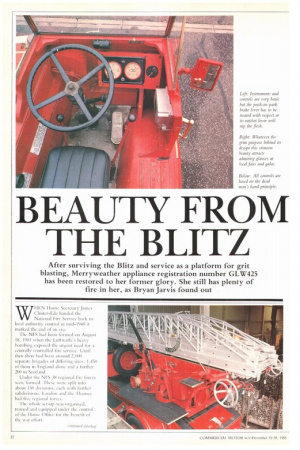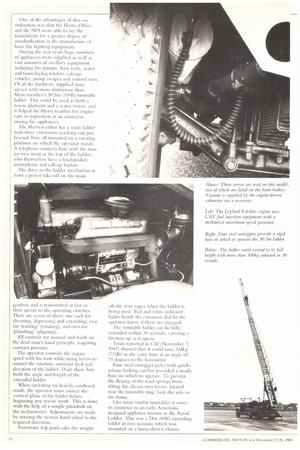BEAUTY FROM THE BLITZ
Page 24

Page 26

Page 27

If you've noticed an error in this article please click here to report it so we can fix it.
After surviving the Blitz and service as a platform for grit blasting, Merryweather appliance registration number GLW425 has been restored to her former glory. She still has plenty of fire in her, as Bryan Jarvis found out
W11EN 1 Ionic Secretary James Chuter-Ede handed the National Fire Service back to local authority control in nodl94 it marked the end of an era.
The NFS had been tbrined on August 18, 1941 when the Luftwaffe's heavy bombing exposed the urgent need for a centrally controlled tire service. Until then there had been ,iround 2,01111 separate brigades of differing sizes, 1,450 of them in England alone and a further 200 in Scotland.
Under the NES 38 regional tire forces were formed. These were split into about 1511 divisions, each with timber subdivisions. London and the •Fhames had tive regional tiffecs.
The whole set-up was organised. trained Mid equipped under the control of the llome Office for the benefit of the war eftOrt.
One of the advantages of this coordination was that the Home Office and the NFS were able to lay the foundations for a greater degree of standardisation in the manufacture of basic tire fighting equipment.
During the war years huge numbers of appliances were supplied as Well as vast amounts of and equipment including tire pumps, hose reels, water and foam-laying tenders, salvage vehicles, pump escapes and control vans. Of all the hardware supplied none served with more distinction than Merryweather's 30.5in (l(X)ft) turntable ladder. This could be used as both a rescue platform and a water tower, and it helped the Merryweather tire engine earll its reputation as an aristocrat among tire appliances.
The Merryweather has a main ladder with three extensions reaching out just beyond 30m; all mounted on a rotating platform on which the operator stands. A telephone connects him with the man (or two men) at the top or the ladder, who themselves have a loudspeaker, microphone and call-up button.
The drive to the ladder mechanism is from a power take-off on the main gearbox and is transmitted at fast or slow speeds to the operating clutches. There are seven of these: one each for elevating, depressing and extending: two for 'training' (rotating); and two for 'plumbing' (aligning).
All controls are manual and work on the dead man's hand principle, requiring constant pressure.
The operator controls the engine speed with his foot while using levers to control the rotation, outward feed and elevation of the ladder. Dials show him both the angle and length of the extended ladder.
When operating on heavily cambered roads, the operator must correct the vertical plane of the ladder before beginning any rescue work. This is done with the help of a simple plumbob on the inclinometer. Adjustments are made by turning the nearest hand wheel in the required direction.
Automatic trip pauls take the weight off the wire ropes when the ladder is being used. Red and white indicator lights beside the extension dial let the operator know if these arc engaged.
The turntable ladder can be fully extended within 30 seconds, carrying a fireman up as it opens.
'Frials reported in CM (November 7, 1947) showed that it could raise 324kg (71511)) in the same time at an angle of 75 degrees to the horizontal.
Four steel outrigger jacks with quickrelease locking catches provided a steady base on which to operate. To prevent the flexing of the road springs from tilting the chassis two levers, located near the turntable ring, lock the axle to the frame.
Like most similar turntables it owes its existence to rn early Americandesigned appliance known as the Aerial Ladder. This was a 24m (801t) extending ladder in two sections which was mounted on a horse-drawn chassis. The rapid development in an power soon encouraged the building of mechanically-operated ladders using PT-Os from the engine or transmission.
With the more recent development of hydraulically powered turntable ladders, mechanically operated models fa victim to more stringent safety standards and working requirements.
During the mid-Sixties these machines were gradually phased out to make way for more modern equipment. The few appliances that managed to survive did so simply by chance.
One such example was the Merryweather turntable ladder registration number GLW425. It was one of a group of six built in 1941 and commissioned into the NFS the following year.
It was based at the old fire brigade headquarters in Greenock, Strathclyde, for the best part of 25 years, attending to German blitz fires and many peace time blazes. When it was finally retired in 1%7 it might easily have been left to rot away. Instead, it was bought by a stone cleaning company in Paisley which saw in the extending ladders a readymade elevating platform that would enable its operatives to blast-clean the outside of the city's tall buildings.
For another II) years the old fire appliance continued to earn its keep trundling up the Glasgow streets that it once protected so well.
Finally, in early 1978 when Board of Trade safety controls put paid to its new-found role, it was sold to an Eastbourne, West Sussex building contracter David Llewellyn.
In spite of his considerable business activities David takes an active interest in restoring old vehicles, mainly vintage Bentley motor cars.
He had been searching for some time for an old fire engine as a suitable restoration project — one with the character and background that he found in the Merryweather.
Although it came down from Glasgow in fair mechanical order, externally it was a mess. To begin with every part was covered in a hardened stone dust that had set like concrete.
Once that had been cleared it was found that most of the original fittings and fixtures had disappeared and the woodwork was virtually destroyed. Restoring it to its former glory took three years of patient research, communicating with other enthusiasts and sheer hard graft, but it has paid off.
Regardless of the grim purpose behind its design, this beauty now attracts much interest and admiring glances when it appears in the local fairs and galas. Credit for its glowing appearance is due also to Eastbourne's firemen who now care for it in their spare time.
The skills and advice of retired firemen proved invaluable for when the rebuilding had been completed, as detailed information and technical publications for that particular design were difficult to obtain.
Merryweather had used a variety of chassis on which to mount its early fire fighting equipment, both for home and export markets.
The subject appliance was fitted on what its present owner believes to be a Titan 11)7 bus chassis. It is powered by an 8.6-litre Leyland diesel engine with Four-speed constant mesh transmission. Maximum engine output is given as 70kW (90hp) at 1,800rpm, while torque peaks at 431 Nin (318Ibft) at 1,100rpm.
From the way that it behaved during a quick 30km round trip between Eastbourne and Pevensey Bay the power output seemed more than adequate for its very high gearing. It has very good acceleration for its years, particularly in the lower gears and at speeds approaching 50kin/h (30mph).
On the dual carriageway with a stiff following breeze behind it, it was just possible to attain 80km/h (50mph), but that was its. limit.
Once the ear had been tuned to the exact engine speed it was possible to change up or down the box very sweetly indeed, but a great deal of care and effort was needed with the unassisted steering, particularly with the long ladder overhang.
In terms of cab comfort it does not fall too far behind. Fresh air ventilation is Al so long as it is not snowing or raining. The seat is firm and the warmth from the engine compartment is no doubt welcome at the year's back end.
How the others in the litter of six have fared compared with GLW425 is not fully known. Two were tracked to Yorkshire, one the Outer Hebrides and a fourth was found in the city of Lincoln where it has served.
Of the fifth there is no trace.












































































